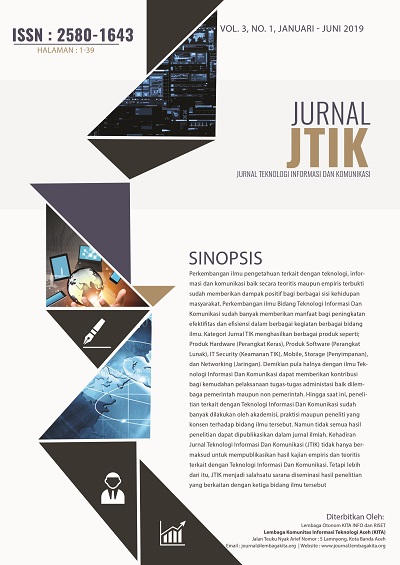Mengidentifikasi Tanaman Beracun pada Pola Daun dengan Jaringan Syaraf Tiruan Learning Vector Quantification
DOI:
https://doi.org/10.35870/jtik.v3i1.47Keywords:
The plant is poisonous, pattern recognition, Learning Vector QuantificationAbstract
Technology nowadays is starting to go very fast, so that all people can use it. Toxic plants are very dangerous if consumed. Therefore to avoid undesirable events, an introduction to the community is needed to find out which plants are poisonous. Plants have many different types to recognize poisonous plants can be seen from the recognition of leaf patterns in these plants. For this reason, in order to determine the use of Learning Vector Quantification artificial neural networks. In this study, the use of input photos obtained from the camera. Photos will be processed later to extract the characteristics. Next, the process of pattern recognition can get the features in the photo. So that later it gets its characteristics. then the classification process uses the Learning Vector Quantification artificial neural network method. This research was conducted to be able to distinguish poisonous plants from those that are not. Which later the data is collected for grouping in accordance with the same data, so that information can be set about the plant.Downloads
References
Asriani, F., & Nugraha, A. W. W. (2009). Pengenalan Pola Aksara Jawa Tulisan Tangan dengan Jaringan Syaraf Tiruan Perambatan-Balik. Dinamika Rekayasa, 5(2), 34–36.
Backpropagation, D. A. (n.d.). Pengenalan pola huruf tulisan tangan menggunakan jaringan syaraf tiruan dengan algoritma, 100.
Firmansyah, R. A., & Odinanto, T. (n.d.). JARINGAN SYARAF TIRUAN PADA APLIKASI SISTEM, 85–90.
Mantala, R. (2014). Pengenalan Pola Karakter Alfabet Menggunakan Artificial Neural Network Dengan Adaptive Linear Neuron, (1), 1–4.
Nugroho, S., & Harjoko, A. (2005). Penerapan Jaringan Syaraf Tiruan Untuk Mendeteksi Posisi Wajah Manusia Pada Citra Digital. Seminar Nasional Aplikasi Teknologi Informasi, 2005(Snati), 1–6.
Pattiserlihun, A., Setiawan, A., Trihandaru, S., Fisika, P. S., Sains, F., Kristen, U., … Indonesia, T. (n.d.). Pola Tulisan Dengan Metode Backpropagation, 1–9.
Prabowo, A., Sarwoko, E. A., & Riyanto, D. E. (2006). Perbandingan Antara Metode Kohonen Neural Network dengan Metode Learning Vector Quantization Pada Pengenalan Pola Tandatangan. Journal Sains & Matematika (JSM), 14, 147–153.
Pratama, A., Tritoasmoro, I. I., Susatio, E., & Kunci, K. (2013). diteliti sebagai Tugas Akhir oleh Isha Nindya Hastari , menggunakan metode adalah JST LVQ ( Jaringan Syaraf Tiruan Learning Vector Quantization ) dan untuk.
Qur’ani, D. Y., & Rosmalinda, S. (2010). Jaringan Syaraf Tiruan Learning Vector Quantization untuk Aplikasi Pengenalan Tanda Tangan (Artificial Neural Network Learning Vector Quantization for Introduction Application Signatures). Seminar Nasional Aplikasi Teknologi Informasi 2010 (SNATI 2010), 1(Snati), 1–5.
Wahyono, E. S., Informatika, J. T., Gunadarma, U., Pola, P., & Polisi, N. (n.d.). IDENTIFIKASI NOMOR POLISI MOBIL MENGGUNAKAN METODE JARINGAN SARAF BUATAN LEARNING VECTOR QUANTIZATION, 1–13.
Downloads
Published
Issue
Section
License
Copyright (c) 2019 Jurnal JTIK (Jurnal Teknologi Informasi dan Komunikasi)

This work is licensed under a Creative Commons Attribution-NonCommercial 4.0 International License.
Copyright and Licensing Agreement
Authors who publish with this journal agree to the following terms:
1. Copyright Retention and Open Access License
- Authors retain full copyright of their work
- Authors grant the journal right of first publication under the Creative Commons Attribution 4.0 International License (CC BY 4.0)
- This license allows unrestricted use, distribution, and reproduction in any medium, provided the original work is properly cited
2. Rights Granted Under CC BY 4.0
Under this license, readers are free to:
- Share — copy and redistribute the material in any medium or format
- Adapt — remix, transform, and build upon the material for any purpose, including commercial use
- No additional restrictions — the licensor cannot revoke these freedoms as long as license terms are followed
3. Attribution Requirements
All uses must include:
- Proper citation of the original work
- Link to the Creative Commons license
- Indication if changes were made to the original work
- No suggestion that the licensor endorses the user or their use
4. Additional Distribution Rights
Authors may:
- Deposit the published version in institutional repositories
- Share through academic social networks
- Include in books, monographs, or other publications
- Post on personal or institutional websites
Requirement: All additional distributions must maintain the CC BY 4.0 license and proper attribution.
5. Self-Archiving and Pre-Print Sharing
Authors are encouraged to:
- Share pre-prints and post-prints online
- Deposit in subject-specific repositories (e.g., arXiv, bioRxiv)
- Engage in scholarly communication throughout the publication process
6. Open Access Commitment
This journal provides immediate open access to all content, supporting the global exchange of knowledge without financial, legal, or technical barriers.












